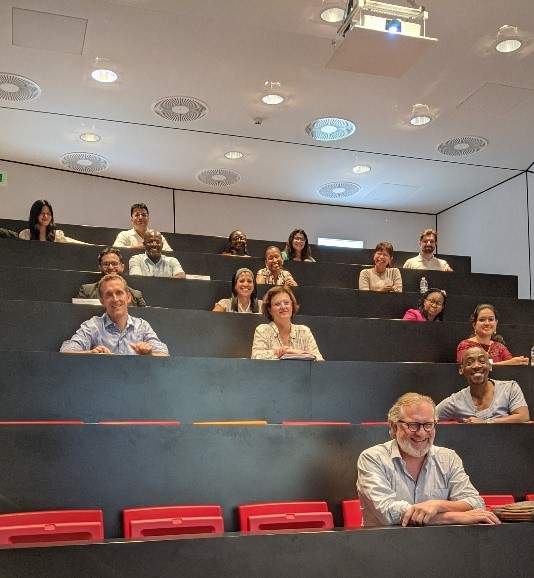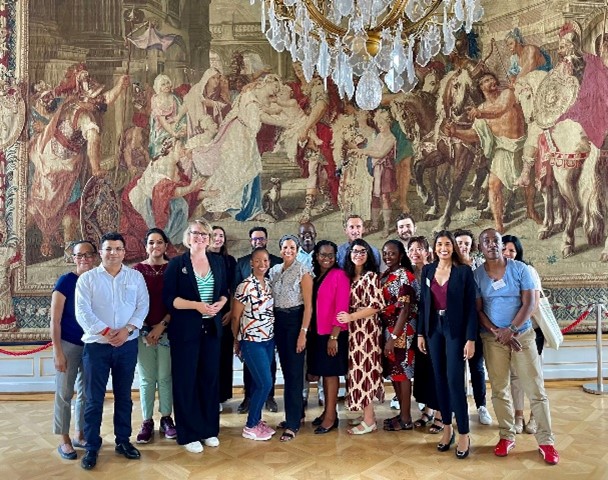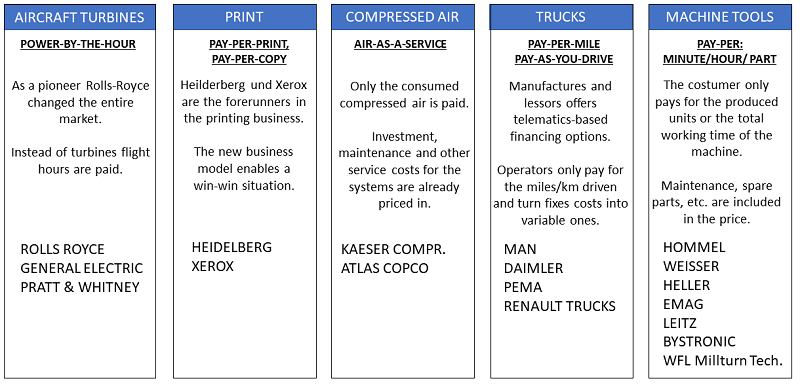WIPO/CEIPI/INPI Advanced Training Course: IP, Technology Transfer and Licensing
Global technology transfer is still a major challenge in a wide range of technology areas. There are several challenges that arise when transferring technology especially from universities to industry. One challenge is that technology transfer between a university and a company typically involves a complex structure with unlike processes, for example in biotechnology. Additionally, technology transfer teams working in technology transfer offices (TTOs) face many challenges in their role to make academic research have as large an impact as possible, and to maintain and improve their office’s reputation within the university and the R&D community. They need to find the most promising research from academics at their institute to engage the industry with and identify not only relevant companies, but the right people within those companies to make contact with. Technology transfer often also is hampered by bureaucracy, inertia, inefficiency, cognitive dissonance, and low research and development activity.
These and many more topics were discussed at the joint WIPO / CEIPI and INPO event held at CEIPI from June 12-23 as part of the Advanced Training Course on IP, Technology Transfer and Licensing at the University of Strasbourg. A key challenge for technology transfer is the so-called tacit knowledge for technology and business. Tacit knowledge is information that one gains through personal experience. It is subjective, informal, and specific to each individual person and environment. Tacit knowledge is often difficult to share with others because it is affected by our personal beliefs and values. It is the expertise, intuition, and insights garnered through practical exposure to a particular subject. While this knowledge can be transferred to a certain level, the proficiency developed by a person is difficult to pass on to others.
 Tacit knowledge is key to delivering most competitive advantage to a company. This tacit knowledge, although difficult to quantify, can only be transferred with appropriate communication between transferor and transferee. Trust is a major factor that determines the transfer of technology. Tacit knowledge can be quite high given the embryonic nature of university technologies and human and institutional connections play a critical role in transferring tacit knowledge between universities and commercial firms.
Tacit knowledge is key to delivering most competitive advantage to a company. This tacit knowledge, although difficult to quantify, can only be transferred with appropriate communication between transferor and transferee. Trust is a major factor that determines the transfer of technology. Tacit knowledge can be quite high given the embryonic nature of university technologies and human and institutional connections play a critical role in transferring tacit knowledge between universities and commercial firms.
In particular, successful technology transfer is itself a business and should be organized and operated as such. The better a TTO knows and understands the future business for the technology to be transferred, the stronger the driving forces and the more desirable the actual transfer is from the perspective of the industrial transfer partner. A business model is a company’s core strategy for creating value and making a profit. It involves identifying the problem, solution, market, and revenue model. It also includes information like the products or services the company offers, the target customers, and the cost structure. A business model can be adjusted based on the market conditions and customer feedback.
 The CEIPI IP Business Academy has organized a workshop entitled: “Models to organize IP-based commercialization from University or R&D institutional research”. The importance of business models in the commercialization of technologies can be illustrated by the historical example of Xerox technology for the photocopier. In 1959, Xerox revolutionized access to information by inventing and commercializing the first plain paper photocopy machine, the Xerox 914. The 914 took over a decade and a significant R&D budget to develop. The machine was revolutionary: averaging 2,000 copies a day or 100 times more than the average business copier at the time. Because the 914 was expensive, it adopted a leasing model to make it more affordable. Xerox added a pay-per-copy plan in order to monetize what they believed would become a copy addiction, but included the first 2,000 copies for free.
The CEIPI IP Business Academy has organized a workshop entitled: “Models to organize IP-based commercialization from University or R&D institutional research”. The importance of business models in the commercialization of technologies can be illustrated by the historical example of Xerox technology for the photocopier. In 1959, Xerox revolutionized access to information by inventing and commercializing the first plain paper photocopy machine, the Xerox 914. The 914 took over a decade and a significant R&D budget to develop. The machine was revolutionary: averaging 2,000 copies a day or 100 times more than the average business copier at the time. Because the 914 was expensive, it adopted a leasing model to make it more affordable. Xerox added a pay-per-copy plan in order to monetize what they believed would become a copy addiction, but included the first 2,000 copies for free.
Japanese copier manufacturers, on the other hand, have developed a completely different business model to make photocopying technology a commercial success. The razor-razorblade business model is a pricing strategy in which a company sells a durable product (the photocopying machine) at a low price or even at a loss, and then makes its profits by selling the consumable goods (the toner cartridges) that are used with the durable product. The idea is to lock customers into the company’s ecosystem by making the initial investment in the durable product affordable, and then generate recurring revenue through the sale of the consumable goods. This model is used in many industries, including printers and ink cartridges, video game consoles and games, and coffee machines and coffee pods.

Source: Findustrial
If the question is how to build as a TTO an effective IP portfolio around a business model – beyond an isolated technology – then you can use the established and very successfully applied SAILS methodology. The SAILS methodology is a heuristic methodology developed by Bruce A. Vojak and Frank A. Chambers for identifying potentially disruptive technologies in complex, technology-based subsystems. The methodology is based on observations of past patterns of change across several industries and can be used to guide the intuition of senior technical visionaries and aid in the formation of intuition for more junior technologists. The five components of this methodology are recurring contributors to disruption at the subsystem level of the value chain: standards, architectures, integration, linkages, and substitutions (SAILS).
The SAILS methodology can be combined in practical application in technology transfer with Design Thinking or IP Designing. This enables the targeted development of effective and attractive IP portfolios along business models for the commercialization of technologies. Design thinking is an innovative problem-solving process that is rooted in a set of skills. It is a non-linear, iterative process that teams use to understand users, challenge assumptions, redefine problems and create innovative solutions for prototyping and testing. The process involves five phases: Empathize, Define, Ideate, Prototype and Test.
In the Empathize phase, you can research your users’ needs and gain an empathetic understanding of the problem you’re trying to solve. In the Define phase, you can state your users’ needs and problems. In the Ideate phase, you can challenge assumptions and create ideas for potential business models. In the Prototype phase, you can start to create solutions and test them out in the Test phase. By using design thinking to develop business models, you can ensure that your business model is centred around the needs of your customers and is able to adapt to changing market conditions.
In the workshop, IP design for designing IP portfolios along business models for the commercialization of technologies in the context of technology transfer was carried out by using various examples. Participants were introduced to the example of the commercialization of magnetic resonance imaging techniques and machines. The different business models such as “transfer-oriented with high throughput” and “pay-per-use with low investment” were shown, and the different IP portfolios required for this were explained. Likewise, the EPA technology transfer study “Perceive3D” from Portugal for a chirurgical navigation tool was explained, where a whole business eco-system beyond the intrinsic technology has to be built to enable commercial success.
The IP design methodology was introduced using the example of developing SME-oriented patent strategies for IoT-based business models. In particular, the AEIOU approach to patent protection for cyber-physical systems was explained using Rittal as an industrial example. In analogy to the design thinking process, the static perspective of business models and system descriptions must be abandoned in order to find the central components relevant for detailed analysis and synthetic inventing within a cyber-physical-system. A dynamic perspective on scenarios is crucial in IP design. An analysis of the points within the value chain at which data are created, documented, processed and machines are controlled based on these data is required in order to further substantiate the problem-solution approaches found.
Finally, five patent types from medical technology were discussed with the participants, which are typical representatives of SAILS approaches in medical technology.
1 . EP2742484B1 Method and apparatus for automatic camera calibration using one or more images of a checkerboard pattern (Integration -> Integration of the calibration)
2 . EP3404436B1 Functional magnetic resonance imaging (Standards -> Improvement of the process)
3 . EP3066596B1 System for displaying and editing data for a medical device (Linkage -> Link between ViewModel and image data functions)
4 . EP3613055A1 Using augmented reality in surgical navigation (Substitution -> Hologram instead of single frames)
5 . EP3959669A1 Diagnosing skin conditions using machine-learned models (Architecture -> Neural network architecture with different elements)
Here you can find the slides from the presentation:



